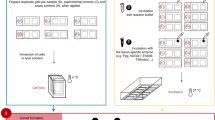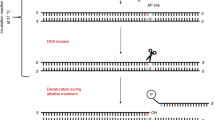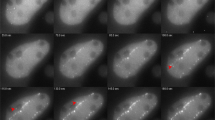Abstract
DIRECTLY or indirectly phosphodiester bonds in DNA are broken when living cells are irradiated by ionising radiations or ultraviolet light. There are various sophisticated techniques for monitoring radiation damage1–6. We describe here how radiation damage in DNA and its repair can be detected simply in the white cells of human blood. The method is very sensitive and should prove useful in screening populations for abnormal repair mechanisms. As there is also great interest in methods for detecting environmental agents that damage DNA2,7, we have applied the method to detect the damage caused by mitomycin C.
This is a preview of subscription content, access via your institution
Access options
Subscribe to this journal
Receive 51 print issues and online access
$199.00 per year
only $3.90 per issue
Buy this article
- Purchase on Springer Link
- Instant access to full article PDF
Prices may be subject to local taxes which are calculated during checkout
Similar content being viewed by others
References
Kao, F. T., and Puck, T. T., J. cell. comp. Physiol., 74, 245–258 (1969).
Perry, P., and Evans, H. J., Nature, 258, 121–125 (1975).
McGrath, R. A., and Williams, R. W., Nature, 212, 534–535 (1966).
Fornace, A. J., Kohn, K. W., and Kann, H. E., Proc. natn. Acad. Sci. U.S.A., 73, 39–43 (1976).
Cleaver, J. E., Adv. radiat. Biol., 4, 1–75 (1974).
Grossman, L., Adv. radiat. Biol., 4, 77–129 (1974).
McCann, J., and Ames, B. N., Proc. natn. Acad. Sci. U.S.A., 73, 950–954 (1976).
Cook, P. R., and Brazell, I. A., J. Cell Sci., 19, 261–279 (1975).
Cook, P. R., and Brazell, I. A., J. Cell Sci. (in the press).
Cook, P. R., Brazell, I. A., and Jost, E., J. Cell Sci. (in the press).
Bauer, W., and Vinograd, J., Prog. molec. subcell. Biol., 2, 181–215 (1971).
Denhardt, D. T., and Kato, A. C., J. molec. Biol., 77, 479–494 (1973).
Szybalski, W., and Iyer, V. N., in Antibiotics, 1 (edit. by Gottlieb, D., and Shaw, P. D.), 211–245 (Springer, Berlin, 1967).
Strauss, B. S., in Chemical Mutagens, Principles and Methods for their Detection, (edit. by Hollaender, A.), 145–174 (Plenum, New York, 1971).
Stich, H. F., in Molecular Mechanisms for Repair of DNA, Part B (edit. by Hanawalt, P. C, and Setlow, R. B.), 773–784 (Plenum, New York, 1975).
Jacob, F., and Wollman, E. L., Ann. Inst. Pasteur, 88, 724–749 (1955).
Thorsby, E., and Bratlie, A., in Histocompatibility Testing (edit. by Terasaki, P. I.), 655 (Munksgaard, Copenhagen, 1970).
Latarjet, R., Morenne, P., and Berger, R., Ann. Inst. Pasteur, 85, 174–184 (1953).
Author information
Authors and Affiliations
Rights and permissions
About this article
Cite this article
COOK, P., BRAZELL, I. Detection and repair of single-strand breaks in nuclear DNA. Nature 263, 679–682 (1976). https://doi.org/10.1038/263679a0
Received:
Accepted:
Published:
Issue Date:
DOI: https://doi.org/10.1038/263679a0
This article is cited by
-
Puromycin aminonucleoside induces oxidant-dependent DNA damage in podocytes in vitro and in vivo
Kidney International (2006)
-
Complex repair kinetics of DNA strand breaks induced by γ-rays or UV radiation in Ehrlich ascites tumour cells
Radiation and Environmental Biophysics (1996)
-
Increasing rates of DNA single-strand breaks in lymphocytes of clinical personnel handling cytostatic drugs
Journal of Cancer Research and Clinical Oncology (1993)
-
Probing DNA superstructure in human quiescent lynphocytes by X-ray-induced double-strand breakage
Radiation and Environmental Biophysics (1992)
-
Comparative studies on the action of 7-N-[2-[[2-(γ-l-glutamylamino)ethyl]dithio]ethyl]mitomycin C and of mitomycin C on cultured HL-60 cells and isolated phage and plasmid DNA
Cancer Chemotherapy and Pharmacology (1990)
Comments
By submitting a comment you agree to abide by our Terms and Community Guidelines. If you find something abusive or that does not comply with our terms or guidelines please flag it as inappropriate.



